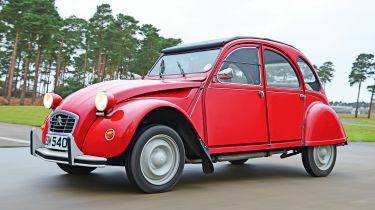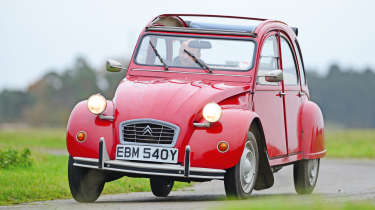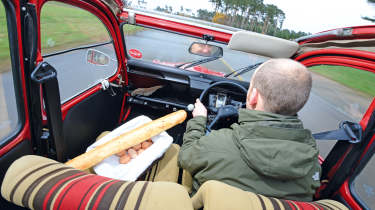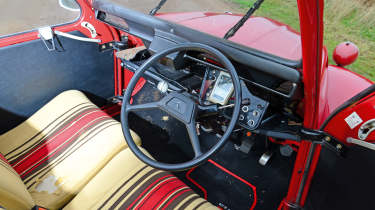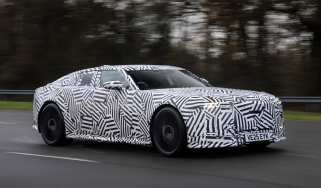Used Citroen 2CV (1948-1990) buyer’s guide: bonkers, but guaranteed to make you smile
A full used buyer's guide on the iconic Citroen 2CV that was in production between 1948 and 1990
Verdict
The thing about the Citroen 2CV is that you have to approach it in a different way from any other car. Designed to provide economy motoring, this quirkiest of classics is brimming with ingenious design details and it’s like no other classic before or since. Nothing will put a smile on your face like a 2CV – every journey is an adventure, and wherever you go you’ll strike up conversations. Performance is limited, but the comfort is amazing and there’s a surprising amount of space for passengers, despite the simplicity. Then there’s the social scene; lots of classic car clubs offer real camaraderie, but 2CV owners take it to a whole new level. The 2CV is bonkers – and so much more fun because of it.
One of the reasons why we love classic cars is because they each have their own individual character. They’re not bland or homogenous, thanks to their distinctive designs and soundtracks.
Nowhere is this more evident than with the Citroen 2CV; it looks, sounds and drives like no other car ever created. As a result it’s arguably one of the most misunderstood cars ever made, but those who get it, really get it, and once you’ve tried one, you’re invariably hooked.
History
The 2CV arrived in 1948 with a 375cc two-cylinder engine; it went on sale the following year. From 1951 there was a van option, before assembly of right-hand-drive cars began in 1953 at Citroen’s Slough factory. A year later, the engine was upgraded to a 425cc unit.
Used - available now
Slough production and UK sales ended in 1960, when a five-ribbed bonnet replaced the previous corrugated item. Front-hinged doors were fitted from 1963 then, in 1967, the Dyane appeared; it was a hatchback 2CV with a slightly bigger bodyshell.
From 1970 there were 26bhp 435cc or 29bhp 602cc engines, and 12-volt electrics replaced the previous the six-volt system. UK sales resumed in 1974, when front disc brakes were adopted. French 2CV production ended in 1988 and two years later the plant in Portugal closed, marking the end of the 2CV.
Which one should I buy?
Darren Arthur runs the 2CV Shop (the2cvshop.co.uk) in Wiltshire. He comments: “Most 2CVs have the 602cc engine, which is no bad thing; even in Europe, cars with the 375cc, 425cc and 435cc engines are rare. If you want something different try a Dyane, which used 2CV running gear, but the larger bodyshell means it’s more spacious, plus it’s a hatchback, so a bit more practical.
“If you go looking for a 2CV in France, don’t pay over the odds, because many of these cars aren’t as good as their owners think.
“The 2CV is simple, but easy to rebuild badly, especially where the chassis is concerned, so you must inspect any potential purchase very carefully. Ideally you should find someone who really knows these cars to go through it for you, so you don’t unwittingly buy a project.”
Prices
Tatty but roadworthy early 2CVs (with the rippled bonnet) fetch £5,500-£12,500. Stick with a later (602cc) car and you can pick up a basket case for around £2k, but something tidy with an MOT is £10k.
There are lots of fully restored 2CVs available for £20k or more, but £15k-£18k bags a superb car that will give years of faithful service. If you’re on a budget you’ll get more for your money if you buy a Dyane. These start at £5k, but you’ll pay twice as much for one that’s been well looked after.
Did you know you can sell your car through Auto Express? We’ll help you get a great price and find a great deal on a new car, too.
On the road
Some of the most talented drivers have owned 2CVs, because there’s so much fun to be had at the wheel.
On paper it doesn’t promise much; the 2CV is notoriously slow and incredibly noisy, while roll in corners is on an epic scale. But driving a 2CV is somehow incredibly fun, and you’ll soon become an expert at conserving momentum. While early cars could manage just 55mph or so, later ones can do 75mph.
What impresses the most in the modern age is the Citroen’s ability to dismiss even the worst potholes and speed bumps, thanks to that super-soft suspension.
Alternatives to the Citroen 2CV
Like the 2CV, the Fiat 500 isn’t over-endowed with power, but it offers just as much charm. The Volkswagen Beetle is another icon that’s short on performance if you want an early edition. Handling is wayward but parts supply excellent, although as with the 500, prices can be high due to the cult status.
The Mini is plentiful, with great parts supply, plus it’s easy to restore and upgrade. Or how about the 2CV’s arch-rival, the Renault 4, which is also cheap to run?
What to look for
Spot the rot
The 2CV rots badly, so you must analyse all of the bodywork and chassis very closely. Good- quality panels are available at reasonable prices, while you can now buy a galvanised chassis on which to rebuild your 2CV.
Seriously cool
The air-cooled engine relies on its lubricant to keep cool, which is why the oil cooler behind the engine-driven fan must be kept clean. Problem is, it’s often coated in grime, leading to the engine running too hot.
Transmission vamp
The first sign of trouble with the gearbox is tired third gear synchromesh, which crunches as you change up from second. A rebuilt gearbox will cost £1,000 plus a day’s labour for a straight swap.
Other problems
Some of the suspension, steering and braking parts might be tired, but everything is available, generally cheaply, and easy to fit on a DIY basis.
Interior
The 2CV’s cabin is incredibly basic with a minimum of instrumentation, the windows don’t even wind up and down (they hinge upwards instead), while the seats are flat and unsupportive. But minimal crash protection means there’s a surprising amount of space inside, although the fitment of a bootlid rather than a tailgate means there isn’t that much luggage capacity.
Reliability
The 2CV was axed just as Auto Express first hit the shelves, so it has never appeared in any of our Driver Power surveys. Although it can be easy to be seduced by the 2CV’s looks and character, nobody buys one on a whim. They join groups like 2CVGB (2cvgb.co.uk) or Citroen Car Club (citroencarclub.org.uk) where they can chat with long-term owners who will highlight the joys and pitfalls of ownership.
Running costs
The 2CV was created for those who needed practical family transport, but had little money, which is why it’s always been cheap to buy and run.
It’s simplicity on wheels; there’s hardly anything to replace and very little to go wrong. As a result, fuel bills should be tiny, while maintenance costs buttons. You can do all routine maintenance yourself, and if you’re not confident, there will be a fellow 2CV fan happy to help out. An oil change every 6,000 miles and a fresh filter every 12,000 miles are the most important things; everything else is replaced when it’s worn out, rather than a fixed schedule. Insurance on a classic policy should be cheap, and road tax is free for most examples; only those built after 1 January 1985 have to pay £220 per year.
But while day-to-day running costs are low, the 2CV’s age means you’ll need to factor in the cost of repairs and restoration, and that’s where things can start to get expensive.
It makes sense to buy one that has been rebuilt on a galvanised chassis, because most 2CVs will have seen some level of restoration work by now, especially UK cars that have been subject to use on salted roads. The 2CV Shop will sell you a reproduction galvanised chassis with a 10-year warranty for £1,253, but you’ll need to factor in the cost of rebuilding the car on top of this once you’ve bought it.
A reconditioned 602cc engine will cost £2,862 (also from The 2CV Shop), but there are used alternatives available. And a complete right-hand-drive body shell is £6,889 from the same supplier, so you can see how easy it is to spend over five figures bringing a car up to scratch if you don’t exercise caution when buying one in the first place.
Check the price of any car with our free car valuation tool...

